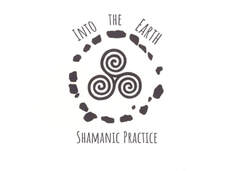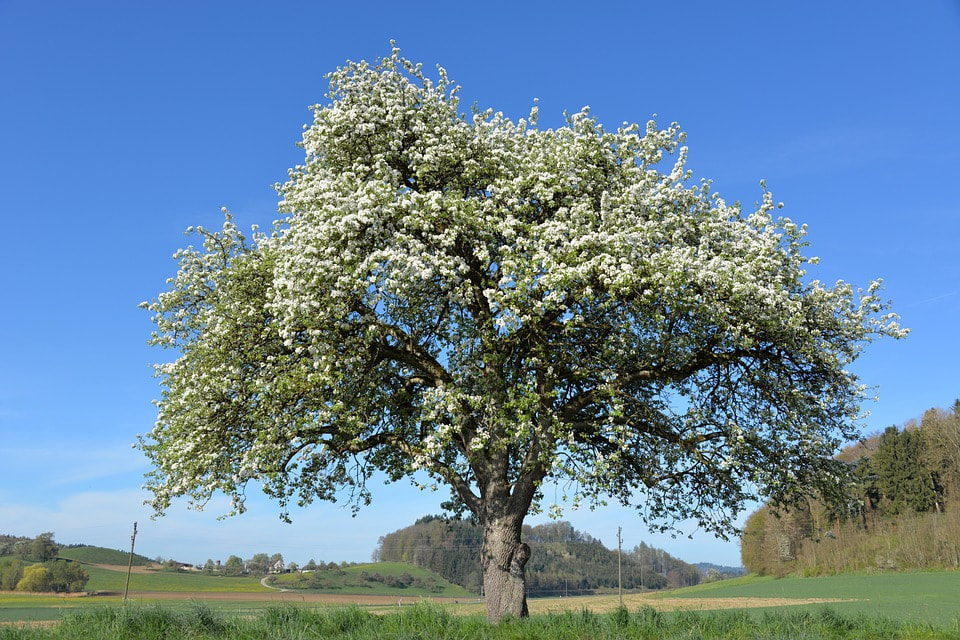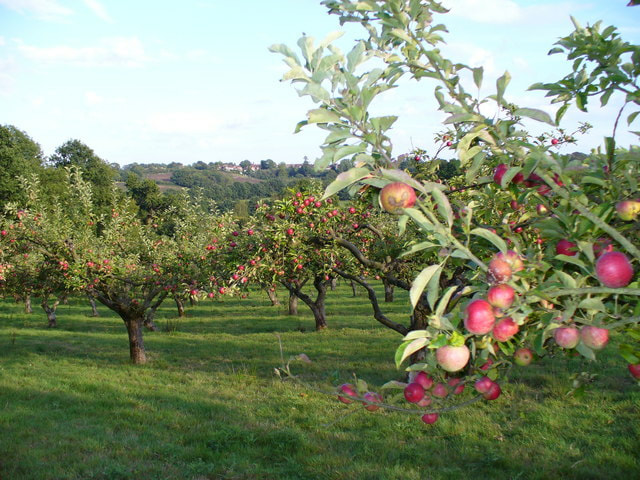| tf-apple.pdf | |
| File Size: | 773 kb |
| File Type: | |
Apple - Tree of Fruition
Malus sylvestris (Latin) - Quert ( Ogham)
Unfailing there the honey and wine
And draughts divine of mead there be,
No ache nor ailing night or day --
Death or decay thou ne'er shalt see!
A hundred swords of steel refined,
A hundred cloaks of kind full rare,
A hundred steeds of proudest breed,
A hundred hounds — thy meed when there!
The royal crown of the King of Youth
Shall shine in sooth on thy brow most fair,
All brilliant with gems of luster bright
Whose worth aright none might declare.
All things I've named thou shalt enjoy
And none shall cloy — to endless life --
Beauty and strength and power thou'lt see
And I'll e'er be thy own true wife!
Michael Comyn (1676–1760)
At the time of Samhain (November) traditionally apples were piled up on the alters to celebrate the coming of the darkest part of the year. Samhain is the end of summer and traditionally a time to remember our ancestors. Orchards come into their own at Samhain (the time when the Otherworlds are most accessible). Apples are piled high and eaten in abundance. Apples are wassailed (celebrated) with song, ritual and toasts. Often libations of cider are poured on the apple tree’s roots.
Here's to thee, old apple tree,
Whence thou mayst bud
And whence thou mayst blow!
And whence thou mayst bear apples enow!
Hats full! Caps full!
Bushel—bushel—sacks full,
And my pockets full too! Huzza!
Trad. from South Hams of Devon, 1871
The apple is a symbol of the Otherworld and its most known today as a temptation for Adam and Eve. The Otherworld can be depicted as a place of lurid temptation that provides us with unnaturally long lives and the ability to indulge in cardinal pleasure or it can be a place of a longing for a more connected spiritual life as Eleanor Merry says – ‘the longing for forbidden lands or for the shining hosts of the Sidhe or for the caves of the hoary sleepers’
This expression of the forbidden lands and pleasure is prolific throughout the Classical poetry of the British lands:
O for ten years, that I may overwhelm
Myself in poesy; so I may do the deed
That my own soul has to itself decreed.
Then will I pass the countries that I see
In long perspective, and continually
Taste their pure fountains.
First the realm I'll pass
Of Flora, and old Pan: sleep in the grass,
Feed upon apples red, and strawberries,
And choose each pleasure that my fancy sees;
Catch the white-handed nymphs in shady places,
To woo sweet kisses from averted faces,--
John Keats
This longing may also be the yearning for our home-coming to return to the source of whence we came.
'The snow-flowers go home when they melt and flow to the sea, and the rock-ferns, after unrolling their fronds to the light and beautifying the rocks, roll them up close again in the autumn and blend with the soil. Myriads of rejoicing living creatures, daily, hourly, perhaps every moment sink into death’s arms, dust to dust, spirit to spirit-waited on, watched over, noticed only by their Maker, each arriving at its own Heaven-dealt destiny. All the merry dwellers of the trees and streams, and the myriad swarms of the air, called into life by the sunbeam of a summer morning, go home through death, wings folded perhaps in the last red rays of sunset of the day they were first tried. Trees towering in the sky, braving storms of centuries, flowers turning faces to the light for a single day or hour, having enjoyed their share of life’s feast-all alike pass on and away under the law of death and love. Yet all are our brothers and they enjoy life as we do, share Heaven’s blessings with us, die and are buried in hallowed ground, come with us out of eternity and return into eternity. Our lives are rounded with a sleep.’
John Muir
It seems the arts take a more potent and enduring form when there is a longing. The greatest composers and poets that we know of that have survived and created art when all the odds seemed to be against them. The poets John Keats and John Clare suffered with severe ill health and the pains Beethoven went through to produce such incredible music only to then lose his hearing.
Maybe it is when we yearn for something beyond our physical world and aim to manifest it through the arts or our spirituality it can bring about a letting go of our physical needs. When this is forced upon us the yearning may create a masterpiece.
Is this then the warning in the garden of Eden of eating the apple of knowledge? Instead of a sinful interpretation of the story it may well be indicating that knowledge comes at a price?
In Britain there are many tales and indeed warnings of the eating of apples. The general agreement amongst these traditions is that the apple is connected to the Otherworld and can confer divine knowledge and inspiration but at a price for once that knowledge is known there is no going back.
Stories speak of Isles of paradise with sacred apple trees. Glastonbury is said to be a physical manifestation of Avalon from the Gaelic ‘Evain avaloch’ meaning holy hill of apples. Thomas of Ercledoune was given the gift of prophecy by the Queen of the fairies and warned he may never return from the Otherlands.
Shelter of a wild hind is an apple.
Shelter of a hind, lunatic, death sense, a time when a lunatic’s senses come back to him.
Excellent emblem, protection.
Force of a man.
Book of Ballymote 1391
The kenning above, ‘excellent emblem, protection’ implies that apple is a symbol of office for those great souls such as Sweeny Geilt, Taliesin and Merlin who dared to risk their lives and especially the sanity of their minds to travel to the Otherworld.
Shamanic traditions across the globe speak of the healers or wise ones who risk their lives for the knowledge to help their tribe or community. The ogham letters for apple are QU or CU a synonym for a warrior in Celtic lore, in this case a spiritual warrior unafraid to face death or travel to the Otherworld.
This longing for the Otherworld in Earth spirituality is a yearning for the land which may well be expressed as a ‘shelter of a wild hind’ mentioned twice in the above kennings for the hind is a key animal of the land.
In Celtic lore creation starts with the land, a primal Mother, a constant that has and will always be there. The guardian of the apple tree is the serpent which leads us once again into the realms of the oldest animals (discussed under the hazel tree), as reptiles are the primal animals of the land as fish are for the sea.
The serpent is totally connected to the earth, meandering along it and living in its depths. The serpent is often seen as a symbol of healing and of raising energy. The symbol of two intertwining serpents is known as Caduceus in Ancient Greek mythology and is associated with the God Hermes.
Hermes is known as the herald of the Gods and protects those who travel such as orators, merchants, heralds and even thieves. This points to his association to those who live outside a settled traditional lifestyle such as outcasts who may well be shunned just as the serpent is.
Caduceus is also a symbol of medicine and healing. In Anglo Saxon herb lore, we come across nine adders in the famously preserved nine herb charm pointing once again to the serpent and its connection to herbs, healing and the land.
The world tree in Norse Mythology is an ash known as Askr Yggdrasill and is the centre of the universe around which everything moves. Its roots represent the Underworld and are said to be guarded by a huge serpent.
The dark depths of life where serpents and insects dwell and our primordial instincts stem from need not be marked as evil. Often the beings of this world are the recyclers, cleaners and messengers of the natural kingdom to which all so-called higher species depend on. In Earth spirituality this connection is encouraged and sought out as being rooted in the world enables us to then ground ourselves in reality and accept all aspects of ourselves as discussed earlier.
However, we do find even in the primal Earth traditions this knowledge also comes at a cost. Odin in Norse mythology lost one eye to drink from the well of wisdom. Boan from the Irish tales looked into the well of Segais and also lost one eye as well as a thigh and a hand.
In Celtic lore there is a posture known as the heron pose. We first hear of it in the second battle of Moytura when Lugh stands on one foot and closes one eye bringing focus and courage to the battlefield. The heron waits patiently to catch a meal and it might be that letting go of the limited side to us enables us to access a greater knowledge and strength. The loss of one eye, thigh or hand in these tales therefore could be the sacrifice of our limited self.
The Apple tree and its uses
Like the Hazel tree, apple is a tree of knowledge and a provider of nutritious food.
In ancient times Pliny recognised 22 varieties of apple but since then over 2000 varieties have made their way across Europe especially from France into Britain. Apples contain much goodness as they are full of sugars, amino acids, vitamins, pectin, mineral salts, malic and tartaric acids.
They are good for infections of the intestine, constipation, fatigue, hypertension, rheumatism, bronchial diseases, coughs and cholesterol.
Our native Crab Apple is easily overlooked in woodlands as it is often grows as a single tree. The true native has long pointed thorns and a rather shrubby untidy appearance which is why it bears the name crab from the Norse word skrab meaning ‘scrubby’.
However, its presence is announced in the autumn when you will often notice copious amounts of small bitter apples upon the tree and the ground. The crab apple however is not to be dismissed by the seeker of better tastes as we must remember this tree is the ancestor of all our cultivated apples and is still the rootstock to which the grafts of cultivated apples are made. Crab apples also make a wonderful jelly when mixed with rowan berries.
'Crab-apples, Crab-apples, out in the wood,
Little and bitter, yet little and good!
The apples in orchards, so rosy and fine,
Are children of wild little apples like mine.
The branches are laden, and droop to the ground;
The fairy-fruit falls in a circle around;
Now all you good children, come gather them up:
They’ll make you sweet jelly to spread when you sup.
One little apple I’ll catch for myself;
I’ll stew it, and strain it, to store on a shelf
In four or five acorn-cups, locked with a key
In a cupboard of mine at the root of the tree. '
Cicely Mary Barker
In the spring it is also easily noticed with its wonderful display of pink blossom which exudes a perfume at night to attract insects, not unlike honeysuckle.
Summaries and Resources for Apple
The apple tree tells us it is a time of fruition, a time to gather our resources and feel abundant. It also protects us from the more negative states of the mind.
The themes to explore include:
Do I feel safe to explore my inner worlds?
Do I judge those aspects of myself that enjoy pleasure?
Am I prepared to face my own issues in order to help others and serve the community?
In the meditation below we sail across the sea to the apple groves of the Celtic Otherworld with the help of poetry from the Voyage of Bran and gentle drumming.
Deepening your connection to Apple
You may wish to connect with an orchard or an apple tree in your garden. This is an opportunity to connect with the relationship between yourself and a tree that is of direct mutual benefit. You may feel the support of the tree and how it offers its fruit to benefit others. The fruit when it falls adds many nutrients to the soil as well as feeding many mini-beasts.
If you have the opportunity, try to spot a crab apple in a native woodland. In the autumn you may notice the fruit upon the tree or its blossom in spring time. The wild crab apple is thorny with bitter fruits you may wish to connect with this tree and see how different it feels from a domesticated apple. As with the other trees sit and absorb its individual energy and essence.
Practical tasks
Rowan and crab apple jelly in September is very tasty provided honey or sugar is added. Simply add your crab apples and rowan berries to a pan of water and heat gently for about ten minutes, drain and add a good amount of honey or sugar. It is the same as a jam recipe usually 1Ib sugar or 454g of honey to a pint of liquid.
You can use the cultivated apple for many dishes such as crumbles and pies or simply boiled or baked. When you eat your apples enjoy the flavour, nutrients and feel the gratitude for all it gives.
Spend this month sheltering under the apple and receive all its wisdom and good health properties.



